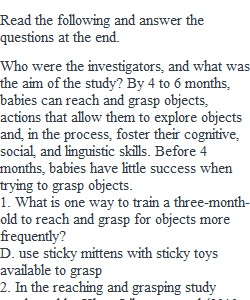


Q Read the following and answer the questions at the end. Who were the investigators, and what was the aim of the study? By 4 to 6 months, babies can reach and grasp objects, actions that allow them to explore objects and, in the process, foster their cognitive, social, and linguistic skills. Before 4 months, babies have little success when trying to grasp objects. If they were better able to grasp, would they benefit from exploring objects? Answering this question was the aim of research by Klaus Libertus and his colleagues, Amy Joh and Amy Needham (2010, 2016). How did the investigators measure the topic of interest? Libertus and colleagues created “sticky” mittens for 3-month-olds. The mittens were covered with Velcro® as were interesting toys. Wearing the mittens, any contact allowed babies to “grasp” and explore the object. For 2 weeks, the babies wore the mittens daily for 10 minutes. In one control condition, babies wore mittens that had no Velcro®; these babies played with toys and, during the daily play sessions, parents held the toys against the mittens simulating the experience of babies wearing sticky mittens). After 2 weeks of training, babies came to the researchers’ lab, where a colorful rattle was placed within their reach; the researchers recorded babies’ efforts to grasp the rattle. About one year later, the procedure was repeated, with the rattle replaced by a bead maze. In two other control conditions, babies received no training at all but were just tested in the laboratory, either as 3-month-olds or as 15-month-olds. Who were the participants in the study? The study included 55 3-month-olds and 15 15-month-olds. What was the design of the study? This study was experimental. The independent variable was the nature of the training experience (sticky mittens, regular mittens, no training). The dependent variable was the percentage of time that the babies tried to grasp the novel toys. The study included a longitudinal component (babies in the mitten conditions who were tested as 3-month-olds and again as 15-month-olds) as well as crosssectional component (babies who received no training and were tested as 3-month-olds or as 15-month-olds). Were there ethical concerns with the study? No. There was no obvious harm associated with wearing the mittens or playing with toys. What were the results? The researchers calculated the percentage of time that babies reached for the toys. As you can see in Figure 3.7, at 3 and 15 months, babies who wore the sticky mittens were more likely than babies in the other groups to grasp objects. In contrast, wearing regular mittens did not affect babies’ reaching. What did the investigators conclude? Training babies to reach had immediate and long-term benefits: Babies who wore the sticky mittens were more likely to reach immediately after training and approximately one year later. Training may have affected babies directly—they learned the benefits of reaching and grasping—and may have affected them indirectly—when parents see babies interested in objects around them, they more often engage their children in object-oriented play. What converging evidence would strengthen these conclusions? One useful extension of this work would be to see if the impact of training persists beyond 15 months and if it extends to domains beyond grasping (e.g., learning the names of objects). Another extension would be to determine whether the training affects parent-child play, particularly play that involves objects. ________________________________________ 1. What is one way to train a three-month-old to reach and grasp for objects more frequently? a. hand infants toys that they appear interested in b. hold toys out in front of infants so they can touch them c. use mittens on the infant and have parents hold the toy to their hand when the infant reaches for the toy d. use sticky mittens with sticky toys available to grasp 2. In the reaching and grasping study conducted by Klaus Libertus et. al (2010, 2016) the independent variable was: a. the number of toys available to reach for b. the amount of time mittens were worn c. the age of the child d. the nature of the training experience. 3. According to the research of Klaus Libertus et. al (2010, 2016), training infants to reach and grasp for an object at three-months-old directly benefited them by a. learning what objects are used for b. recognizing the use of their hands c. learning the benefits of reaching and graspingb. having parents interact with them more PreviousNext
View Related Questions